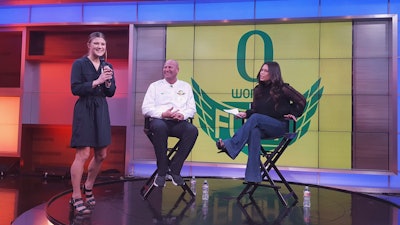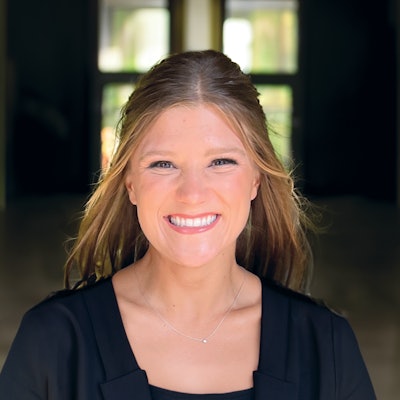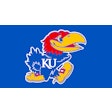
 Alexis Cross
Alexis Cross
What organized sports did you play growing up?
I’m sure my mom probably wished I did less, because growing up I played just about every sport. What stuck through high school was soccer and tennis, and then competitive cheerleading, which is what brought me to acrobatics and tumbling at Oregon.
With acrobatics and tumbling still considered an emerging sport by the NCAA, what are recruiters looking for in prospective college athletes?
They recruit from several different disciplines — competitive cheerleading, gymnastics, diving, acrobatics. All of those are what you could say feeder sports for acrobatics and tumbling, and the sport combines all of those disciplines. One of the reasons that the sport was created was that it provides a really realistic opportunity for women who have trained in any of those disciplines to continue their athletic career and to then specialize in whatever discipline they grew up doing or are most skilled in. I was really fortunate that acrobatics and tumbling was created at the University of Oregon and that I had been going to camps there since I was 11 or 12. I had a pretty good understanding of the sport and the history and the intention behind its creation, which I think made it easier to say, “Yep, I’m gonna sign on for this.”
How widespread is the sport at the college level?
Just for reference, my freshman year, which was in 2014, there were 13 schools in the nation, and I believe they just crossed 50. So, it’s been really amazing to watch it grow and fun to see that a lot of my peers and teammates and other women that I competed against are now head coaches of Division II, Division I programs. It’s really amazing for such young women to have that kind of opportunity.
Did coaching ever cross your mind?
A little bit. My coaches my senior year really had a lot of forethought and were really willing to invest in us as individuals and what we wanted to do, but especially any of us that had interest in coaching. They actually hosted a weekly coaching clinic for any of us who had interests, so I did attend those and learned a lot about what goes into coaching besides actually coaching.
What did you learn?
There’s a lot of things with acrobatics and tumbling, and the scoring system and the strategy, that goes into the skills that you actually put together to receive the scores and check different minimal skill requirement boxes. I learned a lot of things about what’s required of a coach in the forethought in everything they do. But when it came time for me to move into my professional career, it didn’t feel like the right opportunity was there for me in coaching, just in terms of where I wanted to live or what I wanted to be doing. And to be honest, I was kind of ready to try life outside of college athletics a little bit, which didn’t end up happening, but that was my original intention.
How did you end up in the UO athletic department?
I actually skipped graduation and then ended up on a service trip with a group of other student-athletes. We were in Uganda, Africa. I had known about the Women in Flight program at the University of Oregon. The first year of Women in Flight was also my first year at Oregon, so my class was kind of the first full-term beneficiaries of Women in Flight. As I was nearing graduation, I did an internship with Women in Flight and had come to the conclusion that post-grad, I would love to a travel and step away from college athletics and kind of start to identify who I was outside of that. But also, when it came time to come back to a career, I thought it would be really amazing to start a Women in Flight program at a different school. I had always found interest in it. I thought it was really cool that Oregon was doing that, when there weren’t a lot of other schools doing that, either. So, that was my plan. And I found myself on this service trip in Africa, and my now boss was one of the chaperones on the trip, and he had been told to keep an eye out for Lexie. “She has an interest in Women in Flight.” And unbeknownst to me, that position had just opened at Oregon. So, we were sitting there in Africa, putting rocks in a pile, and he says, “Hey, did you know that this position is opening? You would be really good and should apply.” So long story short, I came back from that trip and within a month had started in a big girl job, and in the athletic department that I had just graduated from.
As a freshman student-athlete during that inaugural year of Women in Flight, how aware were you of this new program and what it could do for you?
I think we were in a unique position in that for us, as freshmen, we didn’t know any different. They did a big announcement. I remember talking about Women in Flight, and we were a part of a video shoot and that kind of thing. But it probably wasn’t until even sophomore or junior year that we really started to understand what that program was actually doing for our experience. Things like team-building. You start to understand that, “Oh, we actually probably wouldn’t be able to do this if this program didn’t exist.” And I think the contrast would be much better communicated during that first year by a sophomore or junior, as someone who saw really starkly the comparison between life with Women in Flight and life without.
Was Oregon’s program the first of its kind?
I would definitely say that Women in Flight has become the leader in the space, and the space has kind of become what we and others refer to as a women’s initiative within a collegiate athletic department. And back in 2014, when Women of Fight started, the members of our athletic department who were involved in starting that program did a ton of research across the country, seeing what was currently in place. And while there were initiatives such as a dinner to raise funds for women’s athletics, or a mentorship program for female student-athletes, our big goal — and this came from the intention of the donor who started Women in Flight — was that they wanted to create sustainable support for women’s athletics. So, in that research, they didn’t find anything that checked that box of sustainability. That’s where women in flight became what we believe to be the first of its kind through the lens of sustainability, a program that is structured as an annual fund, and generates pretty consistent revenue per year based on a group of people who give what they can cyclically to support this program with a mission they care about. From there, there were other programs that started to crop up that had more of a sustainable future in mind. And we since have had the incredibly good fortune of being able to talk with and host webinars for schools across the country. I, personally, in my six years at Women in Flight have been able to talk with upwards of 100 schools. We hosted a webinar through the National Association of Athletics Development Directors and had around 200 attendees from all different colleges across the country — D-III, all the way through D-I.
Can you give examples of schools you’ve worked with?
The University of North Carolina is a really good one. We have a great partnership with them and still work closely with them on growing our programs. They’re much newer than us — I think they’re three or four years in at this point — but we share ideas back and forth and really use each other’s experience to continue to build out our programs. It’s also interesting to see some of the schools that we’ve talked to have incredibly different models for how they support women’s athletics. The University of Cincinnati is a good example. I haven’t touched base with them in a long time, so I don’t even know if they’re still doing this, but they were entirely major gifts focused and only dedicated to raising big money really quickly for University of Cincinnati women’s athletics. And they were incredibly successful right off the bat with that. Ours is more, like I mentioned, annual fund focused — smaller gifts that kind of compound and build this cyclical support you can count on. Where they were able to target women to make gifts to women’s athletics, we target awareness and education for everybody.
What is the gender breakdown of your donor base?
We don’t have that data. I get asked for it all the time, and we just don’t keep that record. However, if I had to guess, I would say it’s 50/50, with the majority of gifts being made by a family or a couple.
Your program is approaching full endowment. What does that mean?
The principal of that endowment, based on industry trends, spins off at 8-ish percent, and half of that is reinvested back into the principal, and the remaining comes over to the spendable side. Through our Title IX [Go For Anything] campaign, that was one of our goals. We had previously not had an endowment for Women in Flight at all. You will get Stanford and some of these other institutions where the majority of their fundraising is endowment focused, and they’re constantly building these endowments that now fully support certain operations. Oregon is not at that stage yet. We wanted Women in Flight to start there, and through the campaign, we were able to put $1.7 million into an endowment to start the endowment. And the idea behind that is it becomes our well, where that spinoff of $1.7 million would become basically what is required for the administrative costs of our program — things like donor events, stewardship, marketing, checking the awareness boxes of this program.
Your salary?
My salary is actually absorbed by the athletic department. Several years ago, they committed to funding my salary. It was initially supported by donor revenue, but now it is the athletic department.
That’s a vote of legitimacy, isn’t it?
It is. Absolutely. It was for sure a commitment by them that Women in Flight is here to stay and it’s something that is really valuable to our department.
Is there a timeline when the program will be fully endowed?
So, the $1.7 million is currently endowed now. We do have an additional gift of $5 million that is in the estate of a donor and that is designated to the Women in Flight endowment, at which point, when that comes in, that annual estimated spin-off will cover the current operating costs of Women in Flight. And that includes all the money that we distribute — teambuilding, a proportion of an international tour, scholarships, all of the things that you see represented as we currently support them will be sustained. I hope that we don’t get those dollars for many years.
Not something you can root for.
It’s not, but it’s really incredible for forecasting and the strategic plan for our program going forward. It just totally changed the game for how we are looking at the future.
What’s your day-to-day job like? How much of what you do is the actual “ask” part of fundraising?
I would say it’s very much a hybrid. And for those who are in development, they will resonate with roles that are dedicated to an annual fund and roles that are dedicated to major gifts. And the Women in Flight position is very much a hybrid of those. We also touch the program implementation side a lot more than general fundraisers. Tangibly, what that looks like on a day-to-day basis, we are sustaining an annual fund by creating messaging for solicitations by working with our marketing team to promote and expand on the mission of Women in Flight within our community — Women in Flight theme games, working on partnerships across our campus and with external organizations to promote brand awareness in our community through gear, merchandise. And then also we do quite a bit of corporate sponsorships, whether that’s fully philanthropic or event sponsorship of some kind. And then on the major gifts side, you have very relationship-based fundraising where, to your point, we are making the ask and we are cultivating and bringing donors into our community and presenting opportunities for them to make an impact with women’s athletics, whether that’s for a specific project or just general support of our mission. And then on the program implementation side, we have worked really hard to try to build a pipeline for making sure that the student-athletes are also very involved in Women in Flight and the way in which our dollars do make an impact. It’s dedicated to above-and-beyond support, so it’s important that that above-and-beyond support is actually supporting areas of need first. Within our Student-Athlete Advisory Committee, there is a subcommittee dedicated to women’s athletics called the Women of Oregon, and they are kind of our direct liaison between myself, my Women in Flight team, and the student-athlete population. And that looks really different every year in terms of what that direct implementation looks like, but most often it is them coming to us and saying, for example, “Hey, we’re really stressed with finals week and we would love to do a yoga session for female student-athletes. Is this something Women in Flight can fund?” And then we have access to those funds to right away distribute and tangibly turn those dollars into impact.
What impact do you anticipate Oregon’s move next year to the Big Ten Conference having on your women’s athletics fundraising efforts?
Accepting membership into the Big Ten Conference is a transformational opportunity for the University of Oregon to change the short- and long-term trajectory of our university and athletics department. We’re joining the preeminent athletic-academic conference in the country, and our female student-athletes will have the opportunity to compete at the highest level of collegiate athletic competition. We have no doubt that the stability, exposure and competitive opportunities inherent in the move to the Big Ten will be of great benefit to Oregon women’s athletics and our efforts in enhancing the Women in Flight program.”
As a former female athlete yourself, do you think Title IX has women where they should be in terms of athletics participation and support, or do we have a way to go?
The statistics are staggering in terms of the increase in participation of women and girls in athletics, so I think there we’re actually doing really, really well. But as far as Title IX, as a law, as a whole, and the implementation of that in a way that, in my opinion, equally influences and encourages and supports women in athletics without taking anything away from men’s athletics, I think that’s where we fall into a sticky place sometimes — when we promote one at the harm of the other. And I don’t think that’s what any one, at least at the University of Oregon, that’s not what we hoped for. And that’s personally not what I hope for. All that being said, I think Title IX and the support nationally of women’s athletics, the barriers to entry, the resources available once one is a part of women’s athletics, have a long way to go. And in all of our work around the Go Do Anything campaign, that was the way we talked about Title IX, with a tone of celebration, and with a tone of “This is how far we’ve come.” But there was always that caveat of “But we have a long way to go.” And I feel really fortunate that I’ve been able to talk with so many women — men and women — who have paved the way for women’s athletics at the University of Oregon and beyond. And to then also expand that beyond athletics and hear about women who made amazing strides for Title IX and in other women’s initiatives outside of athletics, I’m continuously in awe of what we’ve been able to do and what they’ve been able to do. I think my passion for this comes from a place of comparison. On the positive side, I have my entire life been supported and encouraged, and felt so valued in my role in athletics. That comes from my parents, that comes from coaches that I’ve had, that comes from this community that I’ve been surrounded by that really does celebrate women in athletics and sees the value in that as a life skill and all the positives that it brings. And I know that there are women out there who have not experienced that still, and so it’s, “How can what we do on a daily basis impact that positively for all women who don’t currently experience that?”





































